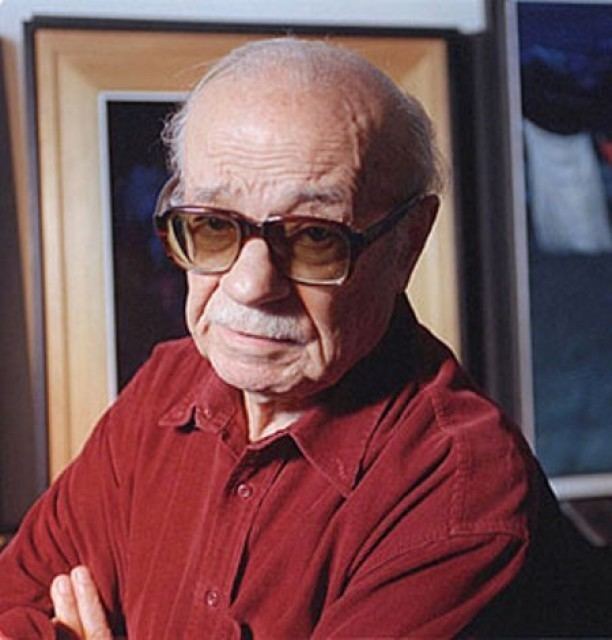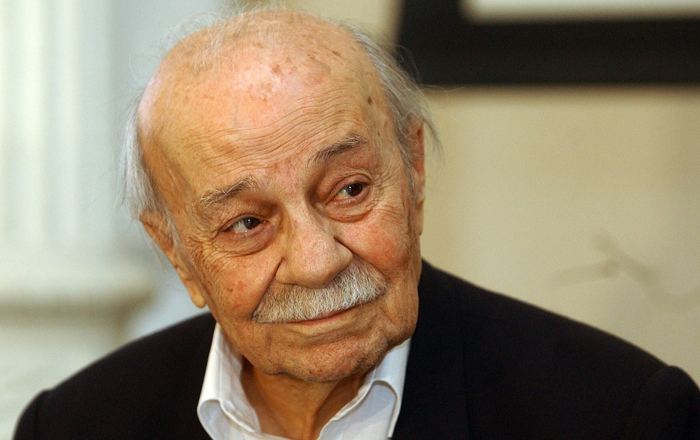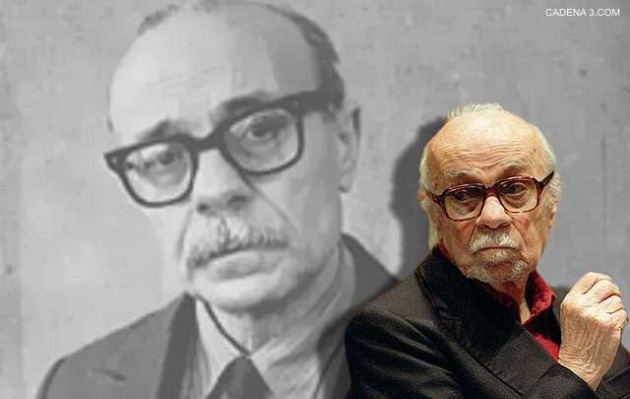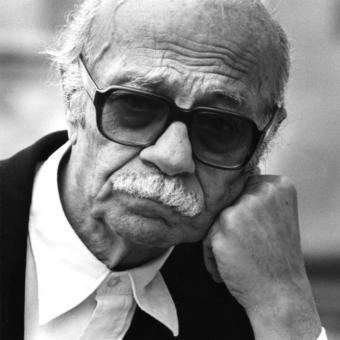Language Spanish Education PhD in Physics Nationality Argentine Name Ernesto Sabato | Ethnicity Italian and Arbereshe Role Writer Citizenship Argentine | |
 | ||
Occupation Novelist and essayist, painter Spouse Matilde Richter (m. 1936–1998) Children Mario Sabato, Jorge Federico Sabato Parents Francesco Sabato, Giovanna Maria Ferrari Books The Tunnel, On Heroes and Tombs, Antes del fin, Abaddon el exterminador, One and the Universe Similar People Jorge Luis Borges, Mario Sabato, Julio Cortazar, Mario Benedetti, Eduardo Galeano | ||
Ernesto sabato june 24 1911 april 30 2011 a short tribute
Ernesto Sabato (June 24, 1911 – April 30, 2011) was an Argentine writer, painter and physicist. According to the BBC he "won some of the most prestigious prizes in Hispanic literature" and "became very influential in the literary world throughout Latin America". Upon his death El País dubbed him the "last classic writer in Argentine literature".
Contents
- Ernesto sabato june 24 1911 april 30 2011 a short tribute
- CONADEP REPORT Ernesto Sabato
- Early years
- His years as a scientist
- Writing career
- Novels
- Essays
- Others
- References

Sabato was distinguished by his bald pate and brush moustache and wore tinted spectacles and open-necked shirts. He was born in Rojas, a small town in Buenos Aires Province. Sabato began his studies at the Colegio Nacional de La Plata. He then studied physics at the Universidad Nacional de La Plata, where he earned a PhD. He then attended the Sorbonne in Paris and worked at the Curie Institute. After World War II, he lost interest in science and started writing.

Sabato's oeuvre includes three novels: El Túnel (1948), Sobre héroes y tumbas (1961) and Abaddón el exterminador (1974). The first of these received critical acclaim upon its publication from, among others, fellow writers Albert Camus and Thomas Mann. The second is regarded as his masterpiece, though he nearly burnt it like many of his other works. Sabato's essays cover topics as diverse as metaphysics, politics and tango. His writings led him to receive many international prizes, including the Legion of Honour (France), the Prix du Meilleur Livre Étranger (France) and the Miguel de Cervantes Prize (Spain).

On the request of President Raúl Alfonsín he presided over the CONADEP commission that investigated the fate of those who suffered forced disappearance during the Dirty War of the 1970s. The result of these findings was published in 1984 bearing the title Nunca Más (Never Again).
CONADEP REPORT Ernesto Sabato
Early years

Ernesto Sabato was born on June 24, 1911, in Rojas, Buenos Aires Province, son of Francesco Sabato and Giovanna Maria Ferrari, Italian immigrants from Calabria. His father was from Fuscaldo, and his mother was an Arbëreshë (Albanian minority in Italy) from San Martino di Finita. He was the tenth of a total of eleven children. Being born after his ninth brother's death, he carried on his name "Ernesto".
In 1924 he finished primary school in Rojas and settled in the city of La Plata for his secondary education at the Colegio Nacional de La Plata. There he met professor Pedro Henríquez Ureña, an early inspiration for his writing career. In 1929 he started college, attending the School of Physics and Mathematics at the Universidad Nacional de La Plata.
He was an active member in the Reforma Universitaria movement, founding "Insurrexit Group" in 1933 – of communist ideals – together with Héctor P. Agosti, Ángel Hurtado de Mendoza and Paulino González Alberdi, among others.
In 1933 he was elected Secretario General of the Federación Juvenil Comunista (Communist Youth Federation). While attending a lecture about Marxism he met Matilde Kusminsky Richter, aged 17, who would leave her parents' house to live with Sabato.
In 1934 he started to doubt communism and Joseph Stalin's regime. The Communist Party of Argentina, which had noted this, sent him to the International Lenin School for two years. According to Sabato, "it was a place where either you recovered or ended up in a gulag or psychiatric hospital". Before arriving at Moscow, he traveled to Brussels as a delegate from the Communist Party of Argentina at the "Congress against Fascism and the War". Once there, fearing not coming back from Moscow, he left the congress to escape to Paris. It was there where he wrote his first novel: La Fuente Muda, which remains unpublished. Once back in Buenos Aires, in 1936, he married Matilde Kusminsky Richter.
His years as a scientist
In 1938 he obtained his PhD in physics from the Universidad Nacional de La Plata. Thanks to Bernardo Houssay, he was granted a research fellowship in atomic radiation at the Curie Institute in Paris. On May 25, 1938 Jorge Federico Sabato, his first son, was born. While in France he made contact with the surrealist movement, studying the works of Oscar Domínguez, Benjamin Péret, Roberto Matta Echaurren and Esteban Francés among others. This would have a deep influence on his future writing.
During that time of antagonisms, I buried myself with electrometers and graduated cylinders during the morning and spent the nights in bars, with the delirious surrealists. At the Dome and in the Deux Magots, inebriated with those heralds of chaos and excess, we used to spend many hours creating exquisite cadavers.
In 1939 he transferred to the Massachusetts Institute of Technology . Once in 1940 he came back to Argentina intent on leaving physics behind. However, serving an obligation to those responsible for his fellowship Sabato started teaching at the Universidad de La Plata for Engineering admission, and relativity and quantum mechanics for post graduate degrees. In 1943, due to an "existential crisis", he left science for good to become a full-time writer and painter.
At the Curie Institute, one of the highest goals for a physicist, I found myself empty. Beaten up by disbelief, I kept going because of inertia, which my soul rejected.
In 1945, his second son, Mario Sabato was born.
Writing career
In 1941, Sabato published his first literary work, an article about La invención de Morel by Adolfo Bioy Casares, in the magazine Teseo from La Plata. Also, in concert with Pedro Henríquez Ureña, he published a collaboration in the renowned Sur magazine.
In 1942, working for Sur magazine reviewing books, he was put in charge of the "Calendario" section and participated in "Desagravio a Borges" in Sur nº 94. He also published articles for La Nación, and his translation of The Birth and Death of the Sun by George Gamow was published. The next year he published the translation for The ABC of Relativity by Bertrand Russell.
In 1945, his first book, Uno y el Universo, a series of essays criticizing the apparent moral neutrality of science and warning about dehumanization processes in technological societies, was published; with time he would turn towards a libertarian and humanist standing. That same year he was awarded a prize by the municipality of Buenos Aires for his book and the honor wand of the Sociedad Argentina de Escritores.
In 1948, after being rejected by several Buenos Aires' editors, Sabato published in Sur his first novel, El túnel, a psychological novel narrated in first-person. Framed in existentialism, it was met with enthusiastic reviews by Albert Camus, who had the book translated by Gallimard into French. It has been further translated to more than 10 languages. Others to enjoy the book included Thomas Mann.
France's literary industry named his book Abaddon el Exterminador (The Angel of Darkness) as 1976's best foreign book.
In 1998 his wife died. In 1999 he acquired the Italian citizenship, in addition to his original Argentine one.
Sabato died in Santos Lugares, on April 30, 2011, two months short of his 100th birthday. His death was as a result of bronchitis according to his companion and collaborator Elvira González Fraga. World reaction to his death said he had "surpassed the world of literature to gain a more iconic status". El Mundo of Spain said he was "the last survivor of Argentine writers with a capital letter".
